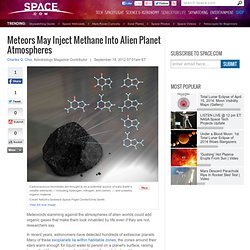

Where's Mars' Methane? Curiosity Draws a Blank. Curiosity comes up empty-handed in its first attempt to find the gas, which on Earth is tied to biological processes.

After more than a month of searching, scientists using NASA's rover Curiosity to study Mars' atmosphere have found no evidence that the planet most like Earth in the solar system has methane, a gas tied to biological processes. The finding adds a new twist into a puzzling story about methane on Mars, which previously was detected by ground-based telescopes and orbiting spacecraft. PHOTOS: Curiosity Flips Powerful Camera's Dust Cap "Maybe its understandable because it's a very early measurement and they're just really still learning the idiosyncrasies of the instrumentation," planetary scientist Michael Mumma, with NASA's Goddard Space Flight Center in Greenbelt, Md., told Discovery News.
Mumma led a team that found methane in Mars' atmosphere in 2003. Methane on Mars. Curiosity Mars Rover Will Hunt for Life's Building Blocks | Space.com The main instrument for the rover’s astrobiology research is the gold-plated Sample Analysis on Mars (SAM), which includes three complex lab tools and is the largest and heaviest (at 88 pounds, or 40 kilograms) on Curiosity.

Many of its capabilities are brand-new or significant improvements on the Viking instruments. [5 Bold Claims of Alien Life] The principal investigator for SAM is Paul Mahaffy of the Goddard Spaceflight Center, who has worked to put together the instrument for more than eight years. He and other NASA scientists are quick to explain that finding organics on Mars will be very hard to do, and that it’s difficult to find organic carbon in rock samples even on Earth. But he sees some real opportunities. Mars rover working on methane mystery - Technology & science - Space - Space.com. There’s growing buzz about data gleaned by NASA’s Curiosity rover on Mars, specifically over the issue of methane detection on the Red Planet.

On one hand, methane can be geological in origin. But then there’s the prospect that the gas is biotic, or caused by living organisms — meaning it could be the gaseous residue of long-extinct microbes or even the output of Martian organisms alive and well today. Curiosity is toting the Sample Analysis at Mars instrument suite, or SAM, an onboard lab that accounts for more than half of the science payload on the 1-ton rover. Though SAM's components would ordinarily fill a laboratory here on Earth, they have been miniaturized to roughly the size of a microwave oven in order to fit inside the robot. Curiosity Mars Rover Will Hunt for Life's Building Blocks. The last time an astrobiology mission landed on Mars, the nation was celebrating the Bicentennial and Gerald Ford was president.

NASA's two Viking landers went with the specific mission to search for signs or examples of Martian life — a task that produced generally negative results, but also decades of controversy and public confusion about the possibilities for life on the planet in our solar system most like ours. NASA's Curiosity rover will land on Mars Sunday night (Aug. 5) to begin what is once again an American astrobiology mission. By design it won’t involve life-detection — it has neither the tools nor the level of sterilization needed for that — but it was assembled to look for the carbon-based building blocks of Martian life and to explore the possible habitats where life might once have existed.
Color coding in this image of Gale Crater on Mars represents differences in elevation, with blue relatively low and tan relatively high. Exploring Gale Crater. The Life on Mars Search: Photo Timeline. Search for Aliens, Extraterrestrials, Martian Life. Life on Mars: Exploration & Evidence. When imagining locations where extraterrestrial life could potentially dwell, few places inspire the imagination like one of Earth's closest neighbors.

For centuries, man has looked to Mars and imagined it as a home for other beings. Over the last fifty years, various missions to the red planet have sought to determine the probability of such an evolution. But how likely is life on Mars? This image from NASA's Curiosity rover looks south of the rover's landing site on Mars towards Mount Sharp. This is part of a larger,high-resolution color mosaic made from images obtained by Curiosity's Mast Camera.
A habitable environment When searching for life, most astrobiologists agree that water is key. This raises a problem on Mars. But Mars wasn't always a desolate wasteland. Tiny UFOs Over the last four billion years, Earth has received a number of visitors from Mars. A microscopic view into a thin slice of the Martian meteorite Nakhla. Searching for life. Mars Methane - Could It Mean Life? Martian Life May Leave Traces in Red Planet's Air. If life exists on Mars, scientists may be able to detect it by measuring the amounts of hydrogen and methane in the Red Planet's atmosphere, a new study suggests.

Finding lots of methane but relatively little hydrogen could be an indicator of active Martian life, according to the study. And scientists could make the needed measurements soon if they wanted to, researchers said. "What’s really nice about this is that it is an incredibly simple method," lead author Christopher Oze, of the University of Canterbury in New Zealand, said in a statement. "All you need to do is measure the methane and hydrogen levels on Mars, something that can easily be done now. " The cold, dry and radiation-blasted Martian surface is generally viewed as inhospitable to life as we know it. Meteors May Add Methane Into Alien Planet Atmospheres. Meteoroids slamming against the atmospheres of alien worlds could add organic gases that make them look inhabited by life even if they are not, researchers say.

In recent years, astronomers have detected hundreds of extrasolar planets. Many of these exoplanets lie within habitable zones, the zones around their stars warm enough for liquid water to persist on a planet's surface, raising hopes that life as we know it might live on these distant worlds. Ground-based observatoriesand proposed-but-cancelled spacecraft such as the European Space Agency's Darwin project or NASA's Terrestrial Planet Finder could scan the atmospheres of exoplanets for signs of extraterrestrial life. Molecules each absorb specific types of light, resulting in patterns known as spectra that allow scientists to identify what the molecules are. Some chemicals or combinations of chemicals might be unique to life as we know it, and could thus serve as strong evidence of aliens.
Curiosity Rover Finds Clues to the Mystery of Mars’ Methane. In August, the Curiosity rover landed on Mars and began gathering data on the planet’s geology and atmosphere.

While NASA has not yet released the Curiosity’s data, expected among its discoveries is a controversial substance: methane. While scientists agree that trace amounts of methane should be present, the concentrations of the gas consistently exceed predicted quantities, leaving researchers to wonder what has produced it. On earth, methane is an extremely common organic compound. It is colorless and odorless but highly combustible, making it useful as fuel.
Methane is the principal component of natural gas and is produced by living organisms as diverse as cattle, termites, and anaerobic bacteria. Mars Methane Mystery: Curiosity Rover May Find New Clues. There’s growing buzz about data gleaned by NASA’s Mars rover Curiosity, specifically over the issue of methane detection on the Red Planet.

On one hand, methane can be geological in origin. But then there’s the prospect that the gas is biotic, or caused by living organisms — meaning it could be the gaseous residue of long-extinct microbes or even the output of Martian organisms alive and well today. Toted by Curiosity is the Sample Analysis at Mars (SAM) instrument suite, gear that takes up more than half the science payload on the 1-ton rover. Though SAM’s components would ordinarily fill a laboratory here on Earth, they have been miniaturized to roughly the size of a microwave oven in order to fit inside the robot. SAM’s duty is to analyze gases that are either "sniffed" directly from the Martian atmosphere (which it has done several times) or extracted from soil or powdered rock samples by heating or chemically treating the samples. Key question Waiting to exhale Modeling research.
NMSU graduate student looks for indications of life on Mars in possible trace methane gas. Methane on Mars may be result of electrification of dust-devils. Methane on Mars has long perplexed scientists; the short-lived gas has been measured in surprising quantities in Mars' atmosphere over several seasons, sometimes in fairly large plumes.

Scientists have taken this to be evidence of Mars being an 'active' planet, either geologically or biologically. But a group of researchers from Mexico have come up with a different – and rather unexpected – source of methane: dust storms and dust devils. "We propose a new production mechanism for methane based on the effect of electrical discharges over iced surfaces," reports a paper published in Geophysical Research Letters, written by a team led by Arturo Robledo-Martinez from the Universidad Autónoma Metropolitana, Azcapotzalco, Mexico. "The discharges, caused by electrification of dust devils and sand storms, ionize gaseous CO2 and water molecules and their byproducts recombine to produce methane. " But if dust devils and dust storms can also produce methane, the mystery becomes a little more mundane.
Mars methane lasts less than a year. Mars methane linked to meteorites. A Sign of Life or an Earth-Based Illusion? We'll Know Soon. NASA will soon have some answers to a long-standing puzzle over what could be producing methane gas detected in the thin Martian air with the August 5th touchdown of the Mars Science Laboratory. It will deliver an S.U.V. Methane on Mars is not an indication of life: UV radiation releases methane from organic materials from meteorites.
It was a sensation when scientists discovered methane in Mars' atmosphere nine years ago. Many saw the presence of the gas as a clear indication of life on the inhospitable planet, as on Earth methane is produced predominantly by biological processes. Others assumed geological processes, such as volcanoes, to be the cause.
What has been missing until now is proof of where the methane actually comes from, however. Researchers at the Max Planck Institute for Chemistry in Mainz and the universities in Utrecht and Edinburgh have now been able to show that methane escapes from a meteorite if it is irradiated with ultraviolet light under Martian conditions. Since meteorites and interplanetary dust from space, which carry along carbonaceous compounds, continuously impact on the Martian surface, the researchers conclude that high-energy UV radiation triggers the release of methane from the meteorites.
UV light decomposes carbon compounds in meteoritic matter. Atmosphere of Mars.